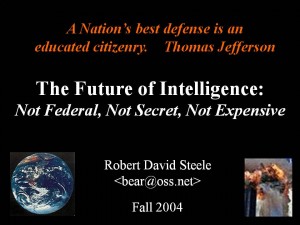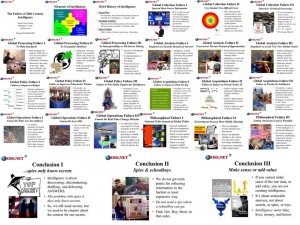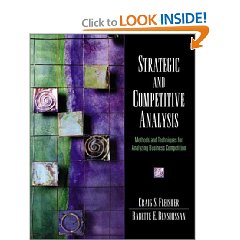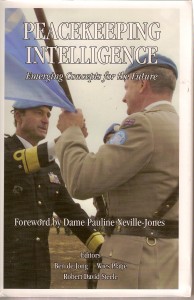
2004 Department of State (March)
Briefings & Lectures, Diplomacy, Intelligence (Commercial), Intelligence (Public)2004 ANALYSIS: All-Source Analysis, Making Magic
Briefings & Lectures, Intelligence (Collective & Quantum), Intelligence (Commercial), Intelligence (Government/Secret), Intelligence (Public)
Technology is not a substitute for thinking. Memorize this sentence, the last sentence in Jim Bamford's book, BODY OF SECRETS: Anatomy of the Ultra-Secret National Security Agency (page 613, literally the last sentence in the book, note the last three words:
“Eventually NSA may secretly achieve the ultimate in quickness, compatibility, and efficiency–a computer with petaflog and higher speeds shrunk into a container about a liter in size, and powered by only about ten watts of power: the human brain.”
Review: Strategic and Competitive Analysis–Methods and Techniques for Analyzing Business Competition
5 Star, Intelligence (Commercial)Rather than outline the wonderful aspects of this book, which other reviewers have done so ably, I will just say that I rank the authors up there with Ben Gilad (Israel), Mats Bjore (Sweden), and Jan Herring, Dick Klavens/Brad Ashton, and Leonard Fuld (USA), and we have made this book “the” text for the annual government all-source analysis training that centers on Open Source Intelligence (OSINT).
This book, in combination with Ben Gilad's Early Warning: Using Competitive Intelligence to Anticipate Market Shifts, Control Risk, and Create Powerful Strategies, the Leonard Fuld's The New Competitor Intelligence: The Complete Resource for Finding, Analyzing, and Using Information about Your Competitors, Dick Klavens and Brad Ashton's Keeping Abreast of Science and Technology: Technical Intelligence for Business, and Earth Intelligence Network's forthcoming edited book, “Commercial Intelligence: From Moral Green to Golden Peace,” are the essential five books for any business intelligence professional or anyone seeking to understand best in class business intelligence.
Four of my own books may also be helpful as strategic context:
The New Craft of Intelligence: Personal, Public, & Political–Citizen's Action Handbook for Fighting Terrorism, Genocide, Disease, Toxic Bombs, & Corruption
Information Operations: All Information, All Languages, All the Time
THE SMART NATION ACT: Public Intelligence in the Public Interest
On Intelligence: Spies and Secrecy in an Open World
Review: Early Warning–Using Competitive Intelligence to Anticipate Market Shifts, Control Risk, and Create Powerful Strategies
5 Star, Intelligence (Commercial)Ben Gilad, arguably one of the top five practitioner-scholars in the competitive intelligence arena (the others, in my opinion, are Jan Herring and Leonard Fuld, his partners; Babette Bensoussan in Australia, and Mats Bjore in Sweden), makes a very important contribution with this book. It is for business leaders what Kristan Wheaton's book, was and is for government leaders.
The author's earlier book, “Business Blindspots: replacing myths, beliefs and assumptions with market realities”, remains one of the single best references for business intelligence professionals (but only available from Infonortics UK), together with Babette Bensoussan and Craig Fleisher's Strategic and Competitive Analysis: Methods and Techniques for Analyzing Business Competition
I regard this book as being primarily for the manager of the business enterprise rather than the business intelligence professional, primarily because it is very helpful in breaking through old mind-sets and suggesting that very specific attitudes and activities must characterize those endeavors that wish to avoid costly surprises. I would say that this book, together with Yale business author Jeffrey Garten's book, The Politics of Fortune: A New Agenda For Business Leaders are “must reads” for the senior executive who desires to not just survive but to excel in the 21st Century.
The author, who has a solid understanding of the history of surprise in military or national security circles, makes the point that surprise does not occur for lack of signs that can be detected, but for lack of a culture and mind-set open to seeing and understanding those signals.
The book combines survey results from professionals attending the Academy of Competitive Intelligence (the single best offering in the world) with real-world accounts, “gray box” supplementals, and “manager's checklists” at the end of each chapter that are in essence an executive summary of the chapter.
This is a 2-3 hour read, and well-worth anyone's time, but especially well-worth the time of the executive who is willing to consider the possibility that they are grossly unaware of real-world external threats to their future bonuses, and that there might be some relatively simple low-cost solutions to dealing with the threat that require, rather than vast sums of money, a change in mind-set.
Other recommended works on my short list (with reviews):
Measuring the Effectiveness of Competitive Intelligence: Assessing & Communicating CI's Value to Your Organization
Keeping Abreast of Science and Technology: Technical Intelligence for Business
The New Competitor Intelligence: The Complete Resource for Finding, Analyzing, and Using Information about Your Competitors
The New Craft of Intelligence: Personal, Public, & Political–Citizen's Action Handbook for Fighting Terrorism, Genocide, Disease, Toxic Bombs, & Corruption
THE SMART NATION ACT: Public Intelligence in the Public Interest
2003 Peacekeeping Intelligence Leadership Digest
Articles & Chapters, Information Operations, Information Society, Intelligence (Commercial), Intelligence (Government/Secret), Intelligence (Public), Peace, Poverty, & Middle Class, Strategy, United Nations & NGOs2002 FAILURE of 20th Century Intelligence
Briefings & Lectures, Intelligence (Collective & Quantum), Intelligence (Commercial), Intelligence (Government/Secret), Intelligence (Public)
BRIEFING: 2002 Steele Failure of 20th Century Intelligence
Continue reading “2002 FAILURE of 20th Century Intelligence”








